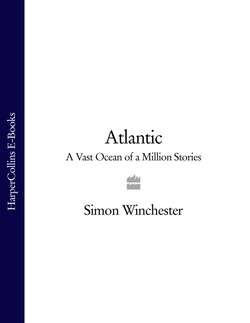Читать книгу Atlantic: A Vast Ocean of a Million Stories - Simon Winchester - Страница 13
4. DEPARTURES
ОглавлениеThe Atlantic, at its beginnings, was a very one-sided ocean, with many peoples distributed along its eastern coasts and yet for many thousands of years no one — no human or humanoid — on its western side. Moreover, its populated coasts were settled initially by newcomers from the continental heartlands, who had little experience with or aptitude for the ways of the sea. Not surprisingly it took a longtime for sailors to venture any distance from the coastline; it took thousands of years for the islands within the Atlantic to be explored; and it look an inordinately long time for anyone to cross the ocean. It was to remain a barrier of water, terrifying and impassable, for tens of thousands of years.
Today’s research, which permits this kind of certainty, is hugely different from the archaeological diggings and probing that went on before Victorian times. The unravelling of the human genome in 2,000 made it possible to find out who in antiquity settled where, and when, simply by examining in great detail the DNA of the present-day inhabitants. The romance of finding potsherds and pieces of decorative artwork remains, of course, but for speedy determination of the spread of humankind, no better way can be devised than the computerized parsing of the genetic record.
Communities were already forming on the Atlantic’s east side while native newcomers were still nervously pushing their way through the woodlands in the west. The first Neolithic peoples in the Levant had already created their world’s first town, Jericho. By now all the world’s peoples were Homo sapiens; no other humankind had made it beyond the end of the Palaeolithic epoch — and their advances, seen from this end of the telescope of time, seem to have taken place at an almost exponential rate. When Jericho was first founded - and this is when the western Atlantic was still essentially unpopulated - its inhabitants were busy carving stones and raising millet, sorghum, and einkorn wheat. Just a few thousand years later, when the first skin-wearing and shivering Ojibwe and Cree and Eskimos were doing their artless best to create the first hardscrabble settlements in the American north, men in the Fertile Crescent and beyond, in places as far away as Ireland, were already throwing pots, were raising dogs, pigs, and sheep, had created from stone the adze and the sickle blade, had built tombs and henges, had used salt to preserve their food, and were on the verge of smelting metals.
• • •
Moreover, these easterners had also made their first boats. Very early settlers in Holland and France had first carved or scorched the interior of fallen trees as much as ten thousand years ago, producing dugouts that they used to navigate their rivers and swamps and cross some of the less formidable estuaries. But these craft were really just canoes, at once both unstable and elephantine, and without keels, sails, rudders, or the kind of freeboard necessary for even the most limited push into the sea. It was to be the Crescent, once again, where the first major advance occurred: in Kuwait, two thousand years later, there appeared a proper sailing craft, made of rushes and reeds and lacquered with bitumen, that was capable of journeying at least through the tricky and unpredictable waters of the Red Sea and perhaps beyond.
Oman also had such a boat, and in 2005 a very eager Omani sultan sponsored a crew of half a dozen to pilot a replica from Muscat to the Indian coast of Gujarat. The journey was to have been 360 miles, but the bitumen must have leaked, because the reeds in the hull became waterlogged three miles off the Arabian coast. The tiny craft promptly sank and everyone had to be rescued by a ship from the Royal Oman Navy.
